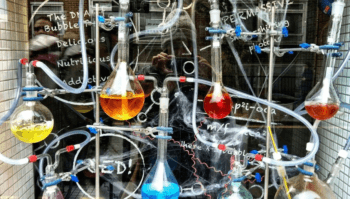The Almost-Magical Properties Of Iron

Some of the most important products in our lives are typically made by applying expensive elements in the periodic table. Synthetic chemistry—the process that makes everything from plastics to pharmaceuticals—relies on these rare molecules to activate the chemical bond necessary to produce these goods.
Virender K. Sharma, Ph.D., professor at the Texas A&M Health Science Center School of Public Health, thinks he’s discovered a better way. He specializes in environmental chemistry, and his particular passion is ferrate, a type of “supercharged” iron—iron that has lost four or more of its electrons. Instead of using elements like gold or palladium, manufacturers could use iron, which is one of the most abundant elements on the planet—and correspondingly inexpensive. It would also generate far less waste, making ferrate-based manufacturing relatively environmentally friendly.
“When you synthesize any organic molecules for industry, carbon-hydrogen bonds need to be activated,” Sharma said. “Gold and palladium both activate this bond, but these are both very expensive—palladium is about $15 per gram—and of a limited supply, so we need to go with simple molecules like iron, and we have breakthrough research in order to figure out how to make ferrate do the same thing.” To compare, iron costs only about .02 cents per gram.
This technology has recently been awarded a patent.
Although ferrate is great for creating things like pharmaceuticals, it’s useful for cleaning them up as well. It is able to transform pharmaceuticals into non-toxic molecules, as Sharma and his collaborators published in a paper in ACS Sustainable Chemistry & Engineering. This is especially important as many drugs, like common antibiotics, are often flushed into in our water supply. Ferrate is able to turn these antibiotics into inert molecules, which should help combat the problem of antibiotic resistance by leaving fewer active antibiotics in the environment.
“Water pollution is a serious problem in China, so when I saw that Dr. Sharma did a lot of this kind of research, I really wanted to work with him,” said Long Chen, a Texas A&M public health Ph.D. student from China and a co-author of the paper. “Ferrate is a very novel technology to treat water, and I’ve been learning so much in Dr. Sharma’s lab.”
Continue reading on Vital Record.
This article by Christina Sumners originally appeared in Vital Record.





